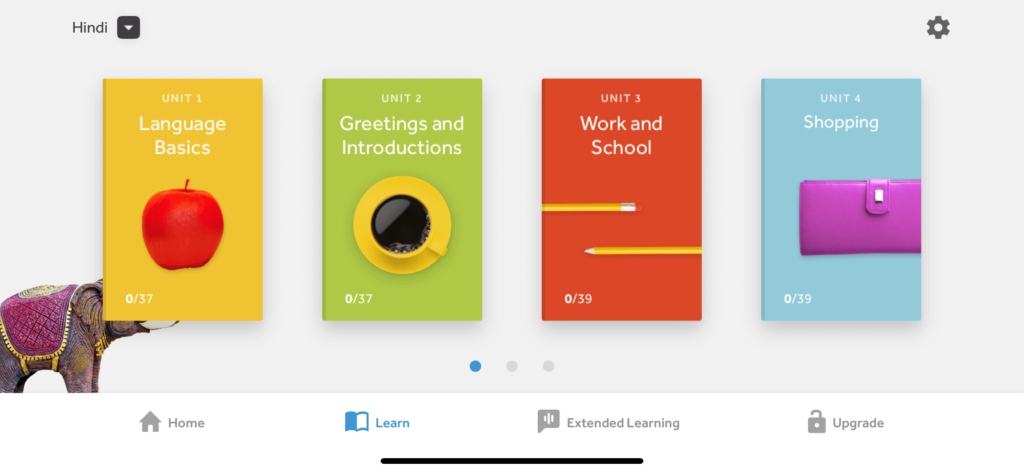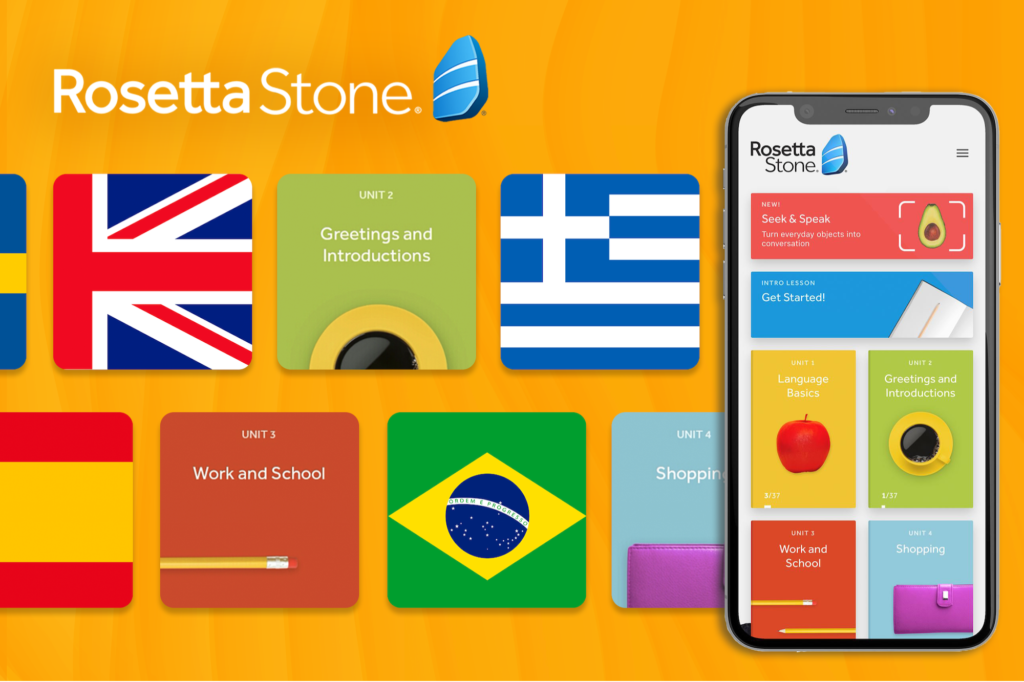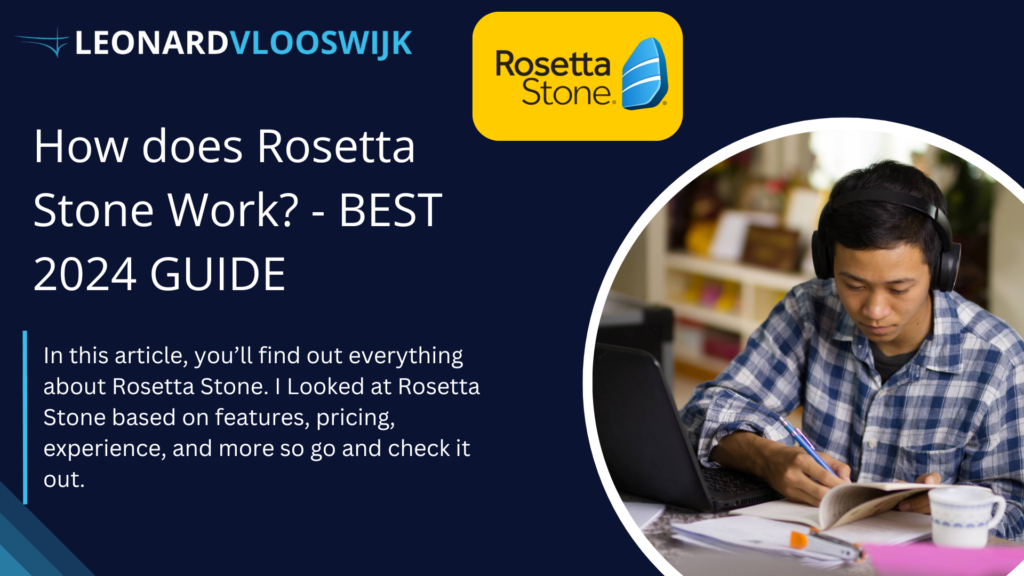Are you curious about learning a new language but unsure where to start? 🌍✨ Dive into our latest blog post to discover “how does Rosetta Stone work” and why it might be the perfect tool for you! Whether you’re a beginner or looking to brush up on your skills, Rosetta Stone’s unique approach has something for everyone.
Join us as we explore the ins and outs of this popular language learning software. From its immersive methodology to flexible pricing options, we’ve got all the details covered. Click through to find out more and see how Rosetta Stone can help you on your language learning journey! 🚀📚
Curious about more Guides, Reviews and Tutorials? CLICK HERE to check out Leonardvlooswijk.com
What is Rosetta Stone?
Alright, let’s get right into it. If you’ve ever wondered “how does Rosetta Stone work,” you’re in the right place. Rosetta Stone is a well-known language learning software that has been around for quite a while. But what exactly is Rosetta Stone, and how does it help you learn a new language? Let’s break it down.
Background and History
First off, let’s talk a bit about the background of Rosetta Stone. The company started in 1992 with the aim of creating a better way to learn languages. The founders believed that traditional methods weren’t effective enough and wanted to make something more immersive. Over the years, Rosetta Stone has evolved significantly, incorporating new technologies and techniques to improve the learning experience. So, when you ask, “how does Rosetta Stone work,” it’s important to know that it’s backed by decades of research and development.
Purpose and Goals
Now, let’s move on to the purpose and goals of Rosetta Stone. The main goal of Rosetta Stone is to help people learn new languages in a way that feels natural. Instead of relying on translation and memorization, Rosetta Stone uses an immersive approach. This means you’ll be learning the language by seeing, hearing, and speaking it, just like you learned your first language. So, if you’re curious about “how does Rosetta Stone work,” it’s all about immersion.

The target audience for Rosetta Stone is pretty broad. It’s designed for anyone who wants to learn a new language, whether you’re a beginner or looking to brush up on your skills. From students to professionals, anyone can benefit from using Rosetta Stone. The focus is on practical language skills that you can use in real-life situations.
In summary, “how does Rosetta Stone work” can be understood by looking at its history and purpose. It’s a language learning tool that uses immersive techniques to help you learn naturally, and it’s designed for a wide range of learners. Now that you have a good understanding of what Rosetta Stone is, you’re ready to dive deeper into how it works and why it might be the right choice for you.
Is French Hard to Learn? – The Best way to Learn French in 2024
How Does Rosetta Stone Work?
Alright, let’s dive into the heart of the matter: how does Rosetta Stone work? Understanding how this popular language learning tool operates will help you see if it’s the right fit for you. We’ll look at the learning methodology, the technology and tools used, and how it personalizes your learning experience.
Learning Methodology
So, how does Rosetta Stone work when it comes to teaching languages? The core idea is immersion. Instead of translating words from your native language, Rosetta Stone teaches you to think in the new language from the start. Here’s how it does that:
- Immersive Learning Experience: When you use Rosetta Stone, you are surrounded by the new language. You’ll see pictures, hear sounds, and read words all in the language you’re learning. This way, you begin to understand meanings directly without translation.
- Use of Images, Text, and Sound: Each lesson combines images, written words, and spoken language. For example, you might see a picture of an apple while hearing the word “apple” spoken in the new language. This multi-sensory approach helps reinforce your learning.
- No Translation Method: By avoiding direct translation, Rosetta Stone helps you think in the new language. You learn the way a child learns their first language, which can be more effective and natural.

Technology and Tools
Next, let’s talk about the technology behind how does Rosetta Stone work. The software uses several advanced tools to make learning easier and more effective:
- Speech Recognition Technology: One of the standout features of Rosetta Stone is its speech recognition technology. This tool listens to your pronunciation and gives you instant feedback. It helps you sound more like a native speaker and improve your speaking skills.
- Mobile App and Desktop Versions: Rosetta Stone is available both as a mobile app and on desktop. This flexibility means you can learn anytime, anywhere. Whether you’re at home or on the go, you can fit language learning into your schedule.
- Interactive Exercises and Games: Learning with Rosetta Stone is not just about listening and repeating. The software includes various interactive exercises and games to keep you engaged and make learning fun. These activities test your knowledge and help reinforce what you’ve learned.
Customization and Personalization
Lastly, let’s look at how does Rosetta Stone work to tailor the learning experience just for you. Personalization is a key part of what makes Rosetta Stone effective:
- Tailored Learning Paths: When you start using Rosetta Stone, the program assesses your current level and creates a learning path suited to you. This means you get lessons that match your skill level and progress at a pace that’s right for you.
- Progress Tracking and Adaptive Learning: Rosetta Stone tracks your progress and adjusts the lessons accordingly. If you struggle with a particular concept, the software will give you extra practice. This adaptive learning ensures you master each topic before moving on
In summary, the answer to “how does Rosetta Stone work” lies in its immersive learning methodology, advanced technology, and personalized approach. By combining these elements, Rosetta Stone helps you learn a new language in a natural and effective way. Now that you know how it works, you can decide if it’s the right tool for your language learning journey.
The 35 Best podcast to learn Italian – FULL 2024 GUIDE
Pros and Cons of Rosetta Stone
Alright, let’s get right into it. When asking “how does Rosetta Stone work,” it’s also important to consider its pros and cons. This will help you decide if it’s the right language learning tool for you. We’ll look at the benefits and the potential drawbacks so you can make an informed choice.
Pros of Rosetta Stone
First, let’s talk about the pros. There are several reasons why people choose Rosetta Stone for learning a new language. Here are some of the main advantages:
- Immersive Learning Experience: One of the biggest strengths of Rosetta Stone is its immersive approach. By surrounding you with the new language, it helps you learn to think and speak naturally. This method answers the question “how does Rosetta Stone work” by showing you how it simulates real-life language use.
- Speech Recognition Technology: Another major pro is the speech recognition technology. This feature listens to your pronunciation and provides instant feedback, helping you improve your speaking skills. It’s a great way to ensure you’re getting the pronunciation right from the start.
- Flexibility and Convenience: Rosetta Stone is available on both desktop and mobile, which means you can learn anytime, anywhere. Whether you have a busy schedule or like to learn on the go, this flexibility is a big plus.
- Engaging and Interactive: The interactive exercises and games make learning fun and engaging. They help reinforce what you’ve learned and keep you motivated to continue. When you ask, “how does Rosetta Stone work,” this element of fun is a key part of the answer.
- Personalized Learning Paths: Rosetta Stone tailors the learning experience to your level and progress. This means you get lessons that match your skills and needs, making your learning journey more effective.

Cons of Rosetta Stone
Now, let’s look at some of the cons. While Rosetta Stone has many strengths, there are also some potential drawbacks to consider:
- Cost: One of the main cons is the cost. Rosetta Stone can be more expensive than other language learning options. This might be a barrier for some people, especially if you’re on a tight budget.
- Lack of Grammar Explanation: Another drawback is the limited focus on grammar rules. While the immersive approach helps you learn naturally, some learners might miss having clear explanations of grammar. If you’re someone who likes detailed grammar lessons, this could be a downside.
- Repetitiveness: Some users find the lessons repetitive. The structured approach might feel monotonous over time, especially if you prefer more variety in your learning activities.
- Requires Self-Discipline: Finally, using Rosetta Stone effectively requires self-discipline. Since it’s a self-paced program, you need to stay motivated and consistent with your practice. If you struggle with staying on track, this could be challenging.
In summary, when considering “how does Rosetta Stone work,” it’s clear that it has both pros and cons. The immersive learning experience, speech recognition technology, and flexibility are major advantages. However, the cost, lack of detailed grammar explanations, potential repetitiveness, and need for self-discipline are factors to keep in mind. Weighing these pros and cons will help you decide if Rosetta Stone is the right fit for your language learning needs.
8 Best Apps to Learn Korean in 2024: My Honest Guide
Rosetta Stone Pricing
Alright, let’s get right into it. If you’re wondering “how does Rosetta Stone work” and considering using it, you’ll definitely want to know about the pricing. Rosetta Stone offers several pricing options to fit different needs and budgets. Let’s break them down so you can see which plan might be best for you.

Monthly Subscription Plan
First up, Rosetta Stone offers a monthly subscription plan. This plan costs $15.99 per month for a three-month commitment. With this plan, you get access to one language. It’s a good option if you want to try out Rosetta Stone without a long-term commitment. So, if you’re asking, “how does Rosetta Stone work in the short term,” this plan gives you a flexible and affordable way to find out.
Lifetime Access Plan
Next, there’s the lifetime access plan. This is a one-time payment of $199.99, and it gives you access to all 25 languages Rosetta Stone offers. That’s right, you pay once and get lifetime access to every language. If you’re serious about learning multiple languages or want the flexibility to switch between languages, this is a fantastic deal. When you think about “how does Rosetta Stone work” for long-term learning, this plan offers incredible value.
Annual Subscription Plan
Lastly, there’s an annual subscription plan. This plan costs $6.99 per month with a twelve-month commitment, and it gives you access to one language. This is a great middle-ground option if you’re looking for a longer commitment at a lower monthly cost. It’s perfect for dedicated learners who want to focus on mastering a single language.
Comparing the Plans
To summarize, here’s a quick comparison of the pricing options:
- Monthly Subscription Plan: $15.99 per month for three months, one language.
- Lifetime Access Plan: $199.99 one-time payment, access to all 25 languages for life.
- Annual Subscription Plan: $6.99 per month for twelve months, one language.
Each of these plans offers a different way to explore “how does Rosetta Stone work.” Whether you’re looking for a short-term trial, long-term commitment, or something in between, there’s a pricing option that can meet your needs.
In conclusion, understanding “how does Rosetta Stone work” also involves knowing the costs involved. These pricing options give you the flexibility to choose the plan that best fits your budget and learning goals. Now that you know the costs, you can decide which Rosetta Stone plan is right for you and start your language learning journey.
Duolingo Pricing: Is Super Duolingo Worth It in 2024?
Conclusion
Alright, let’s get right into it. We’ve covered a lot about how does Rosetta Stone work, and now it’s time to wrap things up. Understanding how Rosetta Stone operates and what it offers can help you decide if it’s the right tool for your language learning journey. Let’s summarize the key points.
How Does Rosetta Stone Work?
We’ve explored the core question: how does Rosetta Stone work? Rosetta Stone uses an immersive learning method, which means you learn by seeing, hearing, and speaking the new language without translation. This approach helps you think in the language naturally. The use of speech recognition technology, interactive exercises, and personalized learning paths all contribute to making Rosetta Stone an effective tool for language acquisition.
The Benefits
There are many benefits to using Rosetta Stone. Its immersive approach helps you learn like a native speaker, and the speech recognition technology ensures your pronunciation is accurate. The flexibility of learning on both desktop and mobile devices allows you to fit language learning into your busy schedule. Interactive exercises keep you engaged and motivated, making the learning process enjoyable.
The Drawbacks
While Rosetta Stone has many strengths, it’s also important to consider the drawbacks. The cost can be higher compared to other language learning tools, and some users might miss detailed grammar explanations. The lessons can feel repetitive, and using the program effectively requires self-discipline and consistent practice.
Pricing Options
When thinking about how does Rosetta Stone work, it’s also crucial to understand the pricing options. Whether you choose the monthly subscription plan at $15.99 per month for three months, the lifetime access plan for $199.99, or the annual subscription plan at $6.99 per month for twelve months, there’s a plan to fit different budgets and needs.
Final Thoughts
In conclusion, Rosetta Stone offers a comprehensive and immersive language learning experience. By understanding how does Rosetta Stone work, you can make an informed decision about whether it’s the right fit for you. The benefits of immersive learning, flexible access, and engaging content make it a strong choice for many learners. However, consider the cost and potential drawbacks to ensure it aligns with your learning style and goals.
Now that you have all the information, you can confidently decide if Rosetta Stone is the right tool to help you achieve your language learning ambitions. Happy learning!

